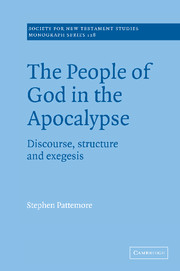Book contents
- Frontmatter
- Contents
- List of figures and table
- Preface
- List of abbreviations
- 1 A question of relevance
- 2 Relevance Theory in biblical interpretation
- 3 A cognitive environment for the Apocalypse
- 4 Souls under the altar – a martyr ecclesiology
- 5 Companions of the Lamb – a messianic ecclesiology
- 6 The New Jerusalem, bride of the Lamb
- 7 Summary and conclusions
- Appendix: Abbreviated discourse outline
- Bibliography
- Index
4 - Souls under the altar – a martyr ecclesiology
Published online by Cambridge University Press: 22 September 2009
- Frontmatter
- Contents
- List of figures and table
- Preface
- List of abbreviations
- 1 A question of relevance
- 2 Relevance Theory in biblical interpretation
- 3 A cognitive environment for the Apocalypse
- 4 Souls under the altar – a martyr ecclesiology
- 5 Companions of the Lamb – a messianic ecclesiology
- 6 The New Jerusalem, bride of the Lamb
- 7 Summary and conclusions
- Appendix: Abbreviated discourse outline
- Bibliography
- Index
Summary
Introduction
We begin our study of the role of the people of God in the second main vision section of the Apocalypse (4:1–22:9) with the vision of the fifth seal. Here, for the first time since the narration opened in 4:1, the people of God take centre stage as the main focus of the account. Previously their redemption has been referred to in the song of the twenty-four elders (5:9–10), who also carry the golden incense bowls containing the prayers of the saints (5:8). They are implicitly among those ‘on earth’ (5:3) who are not worthy to open the scroll, and also a part of the whole created order (including that ‘on earth’, 5:13) that joins the heavenly worship of the Lamb. The question of whether they are the object of some or all of the calamities of 6:1–8 will be addressed shortly, but it is not until 6:9 that a representation of the people of God becomes the direct object of John's vision, and in such a way as to provide the audience, not with an easy point of identification, but with an implicit challenge to identification, which we shall find to be one of the primary modes of John's rhetorical technique. The passage is also important as the starting point for a number of threads which are woven into the whole fabric of the book's tapestry and form the basis for a major conclusion regarding the people of God in the Apocalypse: John challenges his audience to model themselves on the Lamb, finding vindication and victory through suffering and martyrdom (in its double sense of bearing witness and death as a result of witness).
- Type
- Chapter
- Information
- The People of God in the ApocalypseDiscourse, Structure and Exegesis, pp. 68 - 116Publisher: Cambridge University PressPrint publication year: 2004



